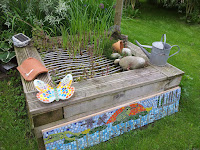Without wishing to sound like a broken record! Our site has been struggling to cope with the recent downpours. Due to continued urbanisation of many green areas, finding innovative solutions to drainage is becoming a hot topic of discussion.
One solution is to turn a negative into a positive by creative channeling of rainwater. We have all no doubt heard of the benefits of collecting rainwater via guttering and water butts, but what about the play opportunities associated with rainwater?
One of the leading voices in innovative play landscapes is Norweigan playground designer Frode Svane. His vision for rainwater play has been incorporated into a guide produced by Planet Earth Ltd. for London Play in association with Natural England.
http://www.londonplay.org.uk/file/1524.pdf
Below are a few extracts from the guide:
'New requirements to install sustainable drainage systems have been introduced following recent catastrophic flooding events in lower river valleys. We [London Play] want rainfall to stay in the local area and sink into the ground, not be whisked away to flood somewhere downstream, but we also want to make rainfall fun for children to play with.
The guidance has been produced with funding assistance from Natural England, and written by Planet Earth Landscape Architects, with advice from Bob Bray Associates and photos from both of them and from Norwegian playground designer Frode Svane.'
Case Studies
Fort Royal School, Worcester

This is a special school with many different needs. Runoff from the upper car park
is cleaned through a permeable pavement and released through a rain chain.
Open rills carry water through a small courtyard and sett channels take water to
the school green space. A formal pond with a glass window allows pupils to look
into the pond safely. A habitat pond will allow pond dipping and act as a home for
wildlife with balance beams over water and access to moving water provide
further understanding of what happens when it rains.
Planet Earth Ltd, St Mary’s Frobisher Park, Peckham, London

Planet Earth have been transforming this declining pocket park into a playful,
magical semi- wooded landscape. Lush woodland planting surrounds a colourful
river channel. The river source starts at the ‘rocky mountain area’ a high point at
the back of the site and flows down along the natural levels into a reedbed in the
river ‘delta’ area. In heavy rainfall children will be able to enjoy chasing rainwater
running along the river channel and through the site. The reedbed has been given
an extra safety precaution to satisfy the local council’s peace of mind using steel
mesh hidden beneath the reeds that is bolted to the surrounding concrete.
One solution is to turn a negative into a positive by creative channeling of rainwater. We have all no doubt heard of the benefits of collecting rainwater via guttering and water butts, but what about the play opportunities associated with rainwater?
One of the leading voices in innovative play landscapes is Norweigan playground designer Frode Svane. His vision for rainwater play has been incorporated into a guide produced by Planet Earth Ltd. for London Play in association with Natural England.
http://www.londonplay.org.uk/file/1524.pdf
Below are a few extracts from the guide:
'New requirements to install sustainable drainage systems have been introduced following recent catastrophic flooding events in lower river valleys. We [London Play] want rainfall to stay in the local area and sink into the ground, not be whisked away to flood somewhere downstream, but we also want to make rainfall fun for children to play with.
The guidance has been produced with funding assistance from Natural England, and written by Planet Earth Landscape Architects, with advice from Bob Bray Associates and photos from both of them and from Norwegian playground designer Frode Svane.'
Case Studies
Fort Royal School, Worcester
This is a special school with many different needs. Runoff from the upper car park
is cleaned through a permeable pavement and released through a rain chain.
Open rills carry water through a small courtyard and sett channels take water to
the school green space. A formal pond with a glass window allows pupils to look
into the pond safely. A habitat pond will allow pond dipping and act as a home for
wildlife with balance beams over water and access to moving water provide
further understanding of what happens when it rains.
Planet Earth Ltd, St Mary’s Frobisher Park, Peckham, London
Planet Earth have been transforming this declining pocket park into a playful,
magical semi- wooded landscape. Lush woodland planting surrounds a colourful
river channel. The river source starts at the ‘rocky mountain area’ a high point at
the back of the site and flows down along the natural levels into a reedbed in the
river ‘delta’ area. In heavy rainfall children will be able to enjoy chasing rainwater
running along the river channel and through the site. The reedbed has been given
an extra safety precaution to satisfy the local council’s peace of mind using steel
mesh hidden beneath the reeds that is bolted to the surrounding concrete.
Planet Earth Ltd, Argyle School, Camden, London
At Argyle School, Planet Earth designed a ceramic surface water-system that
collected rain water from roofs. Using a hand pump, the children could pump
water into the channels and watch it collect in their very own pond with frogs and
water plants.
At Argyle School, Planet Earth designed a ceramic surface water-system that
collected rain water from roofs. Using a hand pump, the children could pump
water into the channels and watch it collect in their very own pond with frogs and
water plants.
















